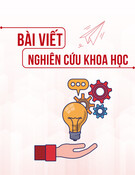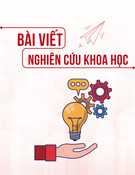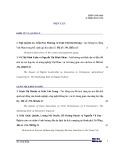
* Corresponding author
E-mail address: mihardjo@gmail.com (L. W. W. Mihardjo)
© 2020 by the authors; licensee Growing Science.
doi: 10.5267/j.uscm.2019.7.005
Uncertain Supply Chain Management 8 (2020) 187–196
Contents lists available at GrowingScience
Uncertain Supply Chain Management
homepage:
www.GrowingScience.com/uscm
Maximising co-creation strategy through integration of distinctive capabilities and customer
experiences in supply chain management
Leonardus W. Wasono Mihardjoa*, Sasmokoa, Firdaus Alamsyaha and Elidjena
aBina Nusantara University, West Jakarta, Indonesia
C H R O N I C L E A B S T R A C T
Article history:
Received June 7, 2019
Received in revised format June
25, 2019
Accepted July 12 2019
Available online
July 14 2019
This paper makes an assessment on the impact of co-creation strategy as part of digital
transformation in Industry 4.0 on supply chain management. We argue that the concept of
strategy has shifted from the competitive strategy into co-creation strategy based on
collaboration value. In developing co-creation strategy, the input is derived from external
factors associated with customer experience and internal factors related to distinctive
capabilities and both focus on core competence development in supply chain management. We
use telecommunication firms as our unit analysis with sample of 35 Indonesian Information
and Communications Technologies (ICT) firms analysed using Partial Least Square (PLS). The
findings show that the developing of co-creation strategy was supported by distinctive
capabilities and customer experience. The findings also indicate that co-creation strategy
emerges as a key in sustaining business of the firms to focus on developing customer
experience and providing distinctive capabilities.
.
by the authors; licensee Growing Science, Canada
20
20
©
Keywords:
Co-creation strategy
Distinctive capabilities
Customer experience
Supply chain
1. Introduction
Industry 4.0 drives businesses into more complex and dynamic. By increasing the complexity, not all
value chains can be fulfilled by internal capabilities, therefore the collaboration with stakeholders to
accelerate processes and innovate business models is important and provide co-creation value to
stakeholders (Zott et al., 2011). There are several studies which indicate the significant impact on the
acceleration of value creation in an established company, especially on consumer sectors (Fuller, 2010).
To anticipate the complexity of products and services, several solutions can be delivered (Kagermann,
2015) such as sharing economy (Matzner et al., 2018), virtualization (Monios & Bergqvist, 2015), and
transforming traditional businesses to be more innovative, standardized, modular, interoperable,
decentralized, real-time, virtualized and service-oriented (Ibarra et al., 2019). The co-creation concept
was first adopted in the marketing context to develop innovation and value creation capabilities by
providing value and collaboration with customers and minimize the cost of exploring innovation
(Prandelli et al., 2006; Sawhney et al., 2005; Stamm, 2004). Co-creation will drive the personalization
of services and products for customers, while optimizing digital technology such as big data, CRM,
and digital marketing will leverage customer value, with an expectation that customers gain experience
(Prahalad & Ramaswamy, 2000)

188
Developing of co-creation with customer and other parties could be accelerated when customer has
experience to sustain the business (Gentile et al., 2007; Ramaswamy, 2011; Romero & Molina, 2009)
through better customer relation (Bolton, 2016; Lemke et al., 2011), better product and service quality
(Lemke et al., 2011), higher customer loyalty (Brakus et al., 2009; Fatma, 2014), and also reducing the
risks to company (Romero & Molina, 2009) since the core of customer experience is associated with
the personal of customers (Ramaswamy, 2011). Looking at the benefits of co-creation and customer
experience in digital context, the need to extend the scope of co-creation is not only for customers but
also for stakeholders and to place it at a strategy level to gain more attention. This will have impact on
improving organization capability and need to distinct the capability compared with the competitors (
Prahalad & Ramaswamy, 2004).
The distinct capability is required to ensure the company focus on strong capability in developing core
competence (Prahalad & Hamel, 1990). In Supply chain management the distinct capabilities have
become the key capabilities development where capabilities shall rely on input of customer experience
and enable co-creation with customer and partners (MYNBAYEBA et al. 2018). The study on
developing network-centric in developing co-creation as part of integration by combination of customer
experience and distinctive capability is still limited with few studies (Coombes & Nicholson, 2013).
The current literature views on co-creation focus on collaboration, while on customer experience and
capability with customers in terms of constructs, applicability and benefit, hence, we present the
concept model of digital transformation based on co-creation strategy to evaluate the role of co-creation
and its relationship with customer experience and distinctive capability. The paper starts with
introduction, literature review, and methodology based on empirical study on Indonesia
telecommunication study, and discussion, conclusion with limitation and future development will
presented next.
2. Literature Review
2.1 Customer Experience
The concept of customer experience has been discussed for more than 15 years but still some
clarifications are needed (Sheth & Uslay, 2007). There is still some confusion between customer
experience and Customer Relation Management (CRM). CEM is more than having a relationship with
customers, but involves a multidimensional view, including the process, brand, and perception. This
also includes sensory (sense), affective (feeling), cognitive (thinking), physical (act), and social-
identity (relation) experiences (Bolton, 2016). Personalisation is a key success, especially when the
digital technology is applied where trust is the main driver (Henfridsson et al., 2014).
CEM as a process that involves the entire experience of customers having an interaction with lifecycle
customers. CEM as a brand is part of perception based on customer experience associated with
previously purchased brands across the touch screen and amplification of the brand’s intentions. CRM
is a part of how customers can experience. Customer experience is constructed in a holistic manner
related to the customer’s cognitive, affective, emotional, social, and physical responses. in retailing
context, customer experiences can be categorized along the lines of the retail mix (i.e., price experience,
promotion experience) (Grewal et al., 2009). Based on the literature review, customer experience in
this study is measured by dimensions including price and promotion, CRM & data analytics, trust &
personalization, and brand performance (Lambekova et al., 2017).
2.2 Distinctive Capability
The concept of capability is defined as an organizational process, system or routine used by an
organization to coordinate resources for productive use (Hubbard & Beamish, 2011). The distinctive
capability concept is derived from the core competence concept to sustain the business (Coimbatore et

L. W. W. Mihardjo et al. /Uncertain Supply Chain Management
8 (2020)
189
al., 1990) The distinctive capability is embedded in an organization as a collection of unique resources
and capabilities. The competitive advantage of organizations depends on resources, capabilities, and
core competency resources defined as a source to create organizational capabilities. Whereas, capability
is the source of core competencies (Hitt et al., 2015). In a digital transformation, the distinctive
capability starts from leadership, people and culture (Jacobi & Brenner, 2017).
The digital leadership is the enable for transformation defined as a digital visioning to optimize the use
of digital technology as part of combination of digital competence and culture (Rudito et al., 2017;
Wasono & Furinto, 2018). In terms of process, digital technology has the ability to shorten the
distribution process through the digitization process and improve the personalized service (Parise et al.,
2016). The digital technology change drives the firm capability to adopt and agility towards market
dynamics and the governance as important factors (Kohli & Johnson, 2011). In this study, distinctive
capability uses digital leadership value, digital culture and competence, digitation & agile operation,
and governance as its dimensions.
2.3. Co-creation strategy
The concept of co-creation is derived from marketing literature, where the marketing transaction is
transformed into collaboration with customers as the main focus of companies (Prahalad &
Ramaswamy, 2000; Ramaswamy & Ozcan, 2013; David Romero & Molina, 2011). The co-creation
concept involves customer as part of the value chain business and as part of open innovation
interconnect with other people (Ramírez-Montoya & García-Peñalvo, 2018). The collaboration is
ranging from co-design, co-production, co-delivery to co-promotion as part of the real time learning
(Frow et al., 2015; Gerlitz, 2015).
Hence, in the development of co-creation, it will be a more holistic to use the value chain approach and
integrates it with existing assets and processes to achieve the performance according to revenue, cost
and quality (Hamidi & Shams Gharneh, 2017; Roser et al., 2013). In this study, co-creation strategy is
assessed by the dimensions of real-time learning, interoperability & integration, interconnection &
collaboration, quality, and revenue & cost (Kozhukhova et al. 2019). The customer experience has
positive relationship with developing co-creation (Ramaswamy, 2011; Ramaswamy & Ozcan, 2013; D
Romero & Molina, 2009). Co-creation can be developed as part of the process of value creation in
developing customer experience, hence we formulate the first hypothesis as follow:
Hypothesis 1: Customer experience has significant influence on co-creation strategy in the Indonesian
ICT industry.
Distinctive organization capability as internal factor of the firm has positive influence to co-creation
(Leonardus Wahyu Wasono Mihardjo et al., 2018) as part of organization capabilities (Sharma et al.,
2014), digitation process (Lenka et al., 2017) and leadership (Leonardus et al., 2018).
Hypothesis 2: Distinctive capability has significant influence on co-creation strategy in the Indonesian
ICT industry.
The research model is shown in Fig. 1.
Fig. 1. The Research Model Framework
Customer Experience
Distinctive Capabilities
Co
-
creation Strategy
H1
H2

190
3. Methodology
This study was conducted through empirical research using a sample of 35 Indonesian ICT firms as a
prototype of the research model in co-creation strategy. Purposive sampling is used, analytical tool and
solution technique are also implemented based on smart PLS. Respondents participated in this research are
people holding managerial positions in the ICT industry, with the respondent distribution as follows :
Table 1
Sample Respondents
Segment
Board/C Level
VP Levels
GM Level
Mgr Level
Network Provider
3
16
3
1
Service Provider
2
1
3
0
Partners
4
0
1
1
TOTAL
9
17
7
2
65% respondents are in network provider, while 17% in service provider and the rest 17% are partners
who support network and service providers in the supply chain and collaboration.
4. Results
PLS consists of inner and outer models. The analysis of inner model shows the relationship between
latent variables - dimensions and indicators. Inner model is evaluated by using goodness-of-fit Model
(GoF) which shows the difference between the values of the observation results with values predicted
by the model.
Table 2
Goodness of fit Model
Variable Cronbach’s
Alpha
Composite
Reliability
R Square Q square
CUSTOMER EXP 0.918 0.929 - 0.413
DISTINCTIVE CAPABILITY
0.910
0.926
-
0.532
CO
–
CREATION STRATEGY
0.940
0.950
0.651
0.662
Table 2 shows the value of R2 of co-creation strategy as an endogenous variable is in the strong criteria
and the value of Q square is in the large criteria. So, it can be concluded that the research model is
either supported by empirical conditions, or the model is fit.
4.1.1. Measurement Model (outer model)
Analysis of the outer model is used as a validity and reliability test to measure latent variables and
indicators in measuring dimension that is constructed. Composite reliability and Cronbach’s Alpha of
variables> 0,70 show that all of variables in the estimated model fulfil the criteria of discriminant
validity. It can be concluded that all of the variables have a good reliability.
Table 3
Loading Factor of Latent Variable-Dimension-Indicator
Indicator-Dimension
SE (
)
t-value
CUSTOMER EXP
→
Price and Promotion
0.561
0.073
7.705*
PP1
←
Price and Promotion
0.792
0.069
11.555*
PP2
←
Price and Promotion
0.729
0.078
9.400*
PP3
←
Price and Promotion
0.860
0.030
28.226*
CUSTOMER EXP
→
CRM & Data Analytics
0.864
0.014
63.350*
CRM1
←
CRM & Data Analytics
0.826
0.043
19.144*
CRM2
←
CRM & Data Analytics
0.905
0.019
48.036*
CRM3
←
CRM & Data Analytics
0.800
0.035
22.672*

L. W. W. Mihardjo et al. /Uncertain Supply Chain Management 8 (2020)
191
Table 3
Loading Factor of Latent Variable-Dimension-Indicator (Continued)
CUSTOMER EXP
→ Trust & personalization
0.874
0.025
34.708*
TP1
← Trust & personalization
0.773
0.054
14.379*
TP2
← Trust &
personalization
0.881
0.027
32.272*
TP3
← Trust & personalization
0.760
0.037
20.557*
TP4
← Trust & personalization
0.783
0.060
13.056*
CUSTOMER EXP
→ Brand Performance
0.878
0.041
21.173*
BP1
← Brand Performance
0.610
0.072
8.513*
BP2
← Brand
Performance
0.805
0.052
15.587*
BP3
← Brand Performance
0.803
0.075
10.673*
BP4
← Brand Performance
0.928
0.017
53.886*
BP5
← Brand Performance
0.675
0.082
8.210*
BP6
← Brand Performance
0.598
0.080
7.440*
BP7
← Brand Performance
0.803
0.052
15.456*
BP8
← Brand Performance
0.863
0.036
23.841*
DISTINCTIVE CAPABILITY
→ Digital leadership value
0.882
0.021
42.975*
DV1
← Digital leadership value
0.680
0.073
9.335*
DV2
← Digital leadership value
0.918
0.018
51.762*
DV3
← Digital
leadership value
0.730
0.077
9.526*
DISTINCTIVE CAPABILITY
→ Digital culture and competence
0.923
0.019
47.732*
DC1
← Digital culture and competence
0.883
0.020
44.102*
DC2
← Digital culture and competence
0.890
0.024
36.843*
DC3
← Digital
culture and competence
0.761
0.053
14.422*
DISTINCTIVE CAPABILITY
→ Digitation & agile operation
0.949
0.010
92.843*
DA1
← Digitation & agile operation
0.843
0.050
16.836*
DA2
← Digitation & agile operation
0.815
0.048
17.018*
DA3
←
Digitation & agile operation
0.857
0.031
28.039*
DISTINCTIVE CAPABILITY
→ Governance
0.662
0.045
14.568*
GOV
← Governance
1.000
1.00
100
-
*
CO
–
CREATION STRATEGY
→ Real Time Learning
0.859
0.041
20.769*
RTL1
← Real Time Learning
1.000
1000
1000
-
*
CO
–
CREATION STRATEGY
→ Interoperability & Integration
0.941
0.020
47.201*
II1
← Interoperability & Integration
0.937
0.019
50.597*
II2
← Interoperability & Integration
0.941
0.016
58.800*
CO
–
CREATION STRATEGY
→ Interconnect &
Collaboration
0.952
0.012
76.989*
IC1
← Interconnect & Collaboration
0.851
0.040
21.435*
IC2
← Interconnect & Collaboration
0.839
0.047
17.823*
IC3
← Interconnect & Collaboration
0.760
0.103
7.404*
IC4
← Interconnect & Collaboration
0.718
0.084
8.589*
CO
–
CREATION STRATEGY
→ Quality, Revenue & Cost
0.962
0.013
74.857*
QRC1
← Quality, Revenue & Cost
0.816
0.033
24.463*
QRC2
← Quality, Revenue & Cost
0.909
0.015
59.052*
QRC3
← Quality, Revenue & Cost
0.803
0.068
11.735*
4.1.2 Structural Model and Hypothesis Testing
The figure shows the complete path diagram based on structural model testing:
Fig. 2. Structural Model Result











![Đề kiểm tra Quản trị logistics [mới nhất]](https://cdn.tailieu.vn/images/document/thumbnail/2025/20251015/2221002303@sv.ufm.edu.vn/135x160/35151760580355.jpg)
![Bộ câu hỏi thi vấn đáp Quản trị Logistics [năm hiện tại]](https://cdn.tailieu.vn/images/document/thumbnail/2025/20251014/baopn2005@gmail.com/135x160/40361760495274.jpg)













